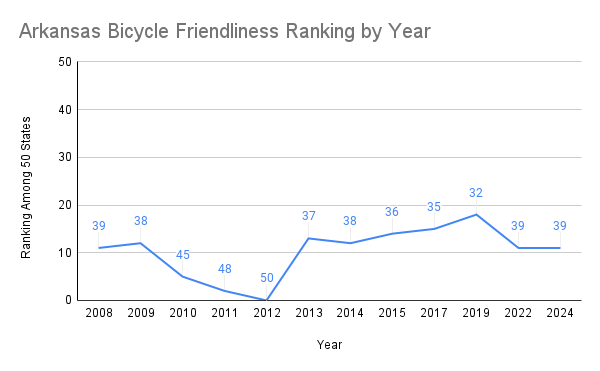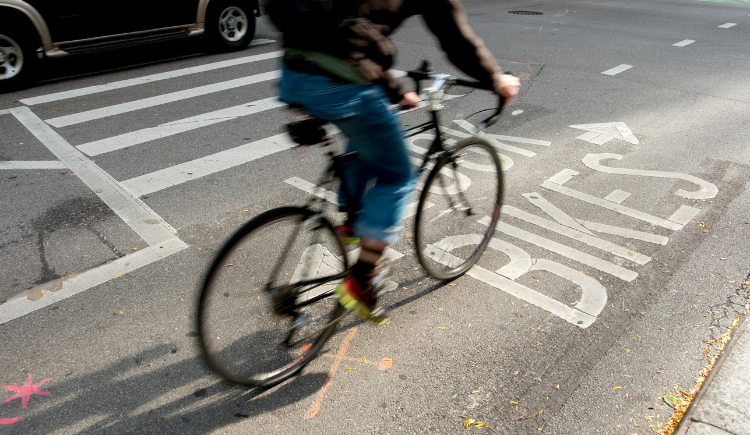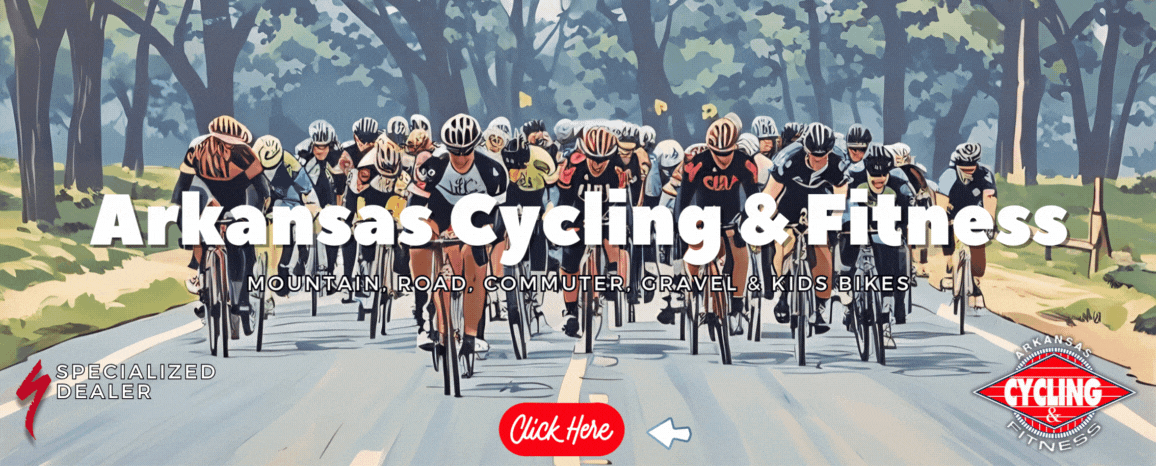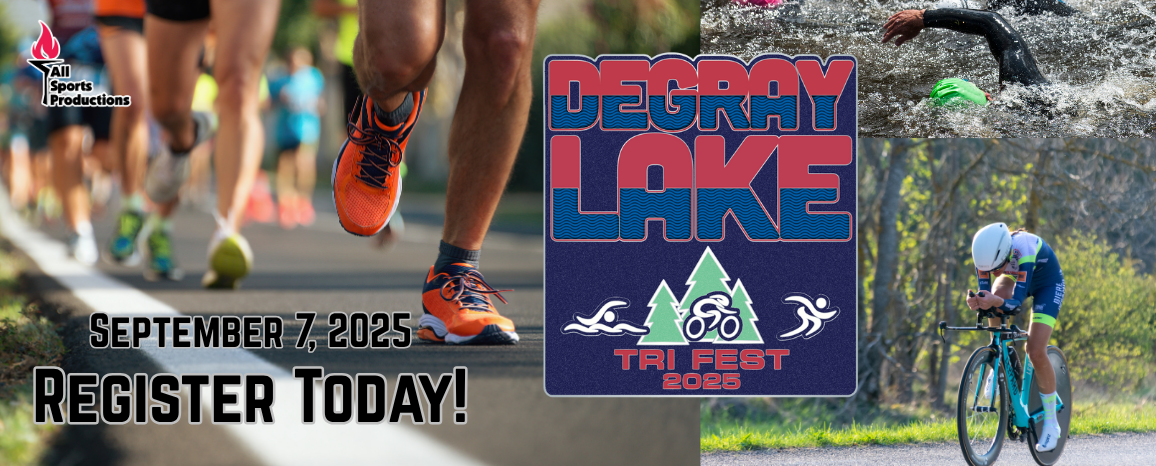For the past 15 years, Arkansas’ journey in the League of American Bicyclists’ Bicycle Friendly State Rankings has been as flat as a Delta bike ride—unfortunately, flatlining near the bottom. The Natural State hit rock bottom in 2012, landing dead last at 50th. In 2008, Arkansas sat at 39th, a rank it holds again today. The high point came in 2019, when the state managed to climb to 32nd, proving there’s potential to pedal forward—if only the momentum would stick.
The League of American Bicyclists’ Bicycle Friendly State rankings aren’t about shredding singletrack, conquering gravel roads, or dominating road races. Instead, they focus on everyday cyclists—those who use bicycles for transportation. These rankings zero in on how safe and accessible the state’s infrastructure is for vulnerable commuters navigating roads, bike lanes, greenways, and protected paths. It’s a measure of how well Arkansas supports people pedaling to work, school, or the grocery store, not just those chasing podiums or scenic views.

A History of Bicycle Safety in Arkansas
Arkansas’ rollercoaster ride in the Bicycle Friendly State Rankings can be traced directly to deliberate actions—or inactions—by the state. The dramatic leap from a dismal 50th place in 2012 to 37th in 2013 was sparked by Morrell Harriman, Chief of Staff to Governor Mike Beebe and an avid cyclist. Harriman, horrified by Arkansas’ rock-bottom status, rallied representatives from key state agencies—including the Department of Transportation (ARDOT), State Police, Department of Health, Parks and Tourism, and the Arkansas Law Enforcement Training Academy (ALETA)—to turn things around.
Each agency pitched in: ARDOT began updating the state’s decade-old bicycle/pedestrian plan (completed in 2017), Parks and Tourism developed a bicycle safety manual, the State Police added bicycle safety questions to the driver’s license test, and ALETA introduced a new module on bicycle and pedestrian laws into law enforcement training. These efforts addressed weak spots in the state’s submissions to the League of American Bicyclists, proving that when Arkansas puts the pedal to the metal, it can make meaningful strides.
Arkansas’ climb to 32nd place wasn’t a fluke—it was the result of deliberate action. In 2017, Governor Asa Hutchinson recognized the growing importance of cycling in the state, especially as Northwest Arkansas became a hub for cycling tourism. After attending the 2016 International Mountain Bicycling Association (IMBA) World Summit in Bentonville, he decided to keep the wheels turning by establishing the Governor’s Advisory Council on Cycling.
This council brought together state agency representatives and private-sector cycling advocates to craft cyclist-friendly policies and legislation. Among their successes were the Arkansas Stop Law (Act 650 of 2019), which allows cyclists to treat stop signs as yields, and the passage of legislation supporting bike racks and bicycles in crosswalks. Through collaboration and smart policymaking, Arkansas showed that when it commits to improving cycling, it can rise in the rankings—and on the road. The council stopped meeting in 2022 which could explain the current rankings.
The 2024 Rankings
In the 2024 Bicycle Friendly State rankings by the League of American Bicyclists, Arkansas is ranked 39th out of 50 states. This ranking reflects the state’s ongoing efforts and challenges in enhancing bicycling conditions.

Key Highlights:
- Bicycle-Friendly Actions: Arkansas has implemented a Safe Passing Law requiring drivers to maintain a minimum distance of three feet when overtaking cyclists. Additionally, the state has developed a statewide bicycle plan within the past decade. However, it lacks a Complete Streets policy, crucial for integrating safe biking and walking infrastructure into transportation planning.
- Safety Concerns: Between 2018 and 2022, nearly 70% of bicyclist fatalities in Arkansas occurred on roads managed by the Arkansas Department of Transportation (ARDOT), indicating a significant need for improved bicycle facilities on state-owned roads.
- Funding and Infrastructure: The state allocates $4.02 per capita in federal funds for biking and walking projects, ranking 16th nationally. Despite this investment, Arkansas does not meet the recommended standard of dedicating at least 2% of federal transportation funds to biking and walking improvements.
- Speed Limit Policies: Arkansas sets default urban area speed limits above 20 miles per hour. Implementing policies that allow communities to establish 20 mph speed limits in urban or residential areas could enhance safety for all road users.
Recommendations for Improvement:
- Adopt a Complete Streets Policy: Implementing such a policy would ensure that transportation planning and design prioritize safe and accessible routes for all users, including cyclists and pedestrians.
- Increase Funding for Bicycle Infrastructure: Allocating a higher percentage of federal transportation funds to biking and walking projects would support the development of safer and more connected bike networks.
- Implement Safer Speed Limits: Providing guidance for communities to establish 20 mph speed limits in urban and residential areas can significantly reduce the risk of accidents involving cyclists and pedestrians.
By addressing these areas, Arkansas can enhance its bicycle friendliness, promoting safer and more accessible cycling opportunities for residents and visitors.
The Future of Bicycle Friendliness in Arkansas
Kim Sanders is the Bicycle Pedestrian Coordinator for ARDOT. She submits the information for the State of Arkansas to the League of American Bicyclists for their rankings. When asked about the latest ranking she said, “I’m not disappointed in 39th. We were 39th last time, so we didn’t drop. Honestly, I was pleasantly surprised. I fully expected the state to fall below 39th.”
She also listed five ways we can improve our rankings in the future:
- ARDOT needs a Complete Streets Policy.
- ARDOT needs to update our 2017 Bicycle & Pedestrian Plan.
- We need to spend more federal dollars (meet the LAB’s 2% threshold) on bicycle/pedestrian accommodations.
- Have an active Statewide Advocacy group. Ms. Sanders is currently assisting with the creation of such a group.
- Other items the League would like to see are increased ridership, improved safety, and addressing speed limits on the highway system in urban areas.
Arkansas has proven it can move the needle on bicycle friendliness—but only when state leadership treats it as a priority. The problem? Consistency. The progress made during Governor Beebe’s administration fizzled out, and the cycling council dissolved with the next change in leadership. That lack of follow-through has kept Arkansas stuck in the lower ranks.
Case in point: the Arkansas River Trail in Little Rock has remained unfinished and unsafe for decades, a glaring missed opportunity. Meanwhile, law enforcement in Fort Smith focuses on ticketing jaywalkers instead of tackling real threats like unsafe roads and distracted drivers. Without sustained effort and a shift in priorities, Arkansas will stay pedaling in place at the bottom of the rankings—hardly the kind of ride anyone wants to take.







2 Responses
Thanks for the excellent summary Joe. A sad state if affairs.
I don’t agree with the lowering speed limits to 20 mph… even bikes can go faster than that. Most residential areas now are 25 or 30. The bigger problem is continuing to build roads with no shoulder at all. Even a small 2 foot shoulder would help immensely. The 6-8″ that are there now is unusable forcing bicycles out into the main roadway and angering cars.
Additionally perhaps finding the commonly ridden roads and make bike lanes on those. Not every road needs a bike lane, but some of the more common ones to allow for easier communing and coexisting with cars would be great. For example in central Arkansas, highway 300 from Pinnacle Mountain out to the community of Roland is a ride most cyclists will not undertake unless in a big group. Long standing history of aggressive drivers running cyclists into ditches and deploying tacks all over the road make it unsafe. If there was a bike lane along that stretch of road I think most of those problems would go away.